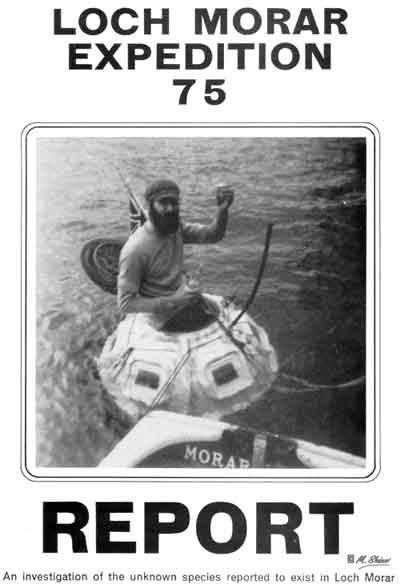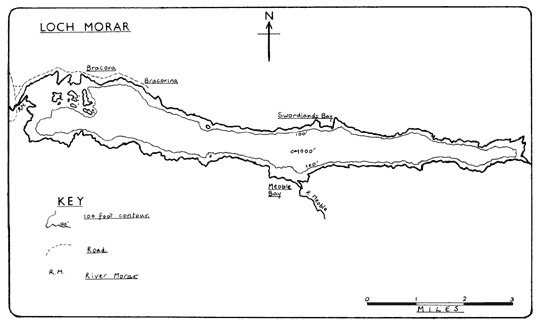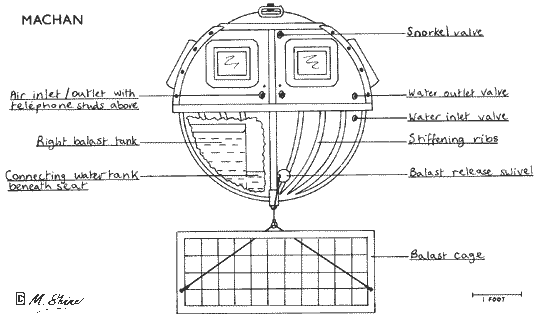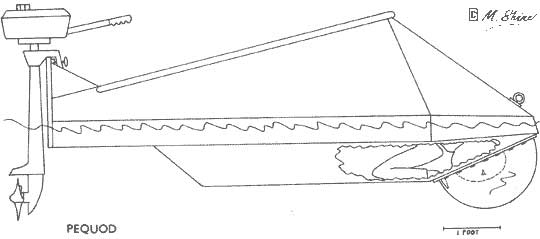Loch Morar Expedition Report 1975
© Shine.
May be used for private research only. All
other rights reserved.

This
year an attempt was made to investigate the
cause of sightings indicating the presence
of a large unknown animal in Loch Morar, with
characteristics similar to those familiar
at Loch Ness.
The
following report is to record this, since
though we have failed so far, there are elements
in our objectives, attitude and method, which
are new to investigations of this kind. Furthermore,
we have broken ground along our chosen lines
of approach, and so have confidence in seeking
support for a continuation and extension of
our activities next year.
The
expedition took place between August 15th
and the end of September and consisted mainly
of zoology students of Royal Holloway College,
University of London, who manned the equipment
which I had designed and built in collaboration
with Mr. Trevor Wicks.
Expedition
Members
M.
Barrett
L. Davis
I. Ericke
D. Foakes
P.
Kennedy
T. Leighton
I. Montgomery Campbell
G. Orton
T. Parker
M. Parsons
C. Penfield
|
S. Robinson
J. Saye
D. Sharp
D.Shirt
N. Smith
A. Thorogood
R. White
M.
Whitehead
T. Wicks
A. Wyatt |
ACKNOWLEDGEMENTS
We
wish to express our gratitude to the following
for their co‑operation encouragement:
Mr.
Tim Dinsdale, A.R.AeS
The
Loch Morar Survey. 1970-72
Elizabeth
Montgomery Campbell, MJI
Dr.
David Solomon
The
Master of Lovat
The
residents of Morar, particularly Mr. McCleod
(proprietor of the Morar Hotel) and
Mr.
Walker, Mr. Angus Cameron, Mr. Morrison and
Mr. Mc.Donnell
.
We
also record our appreciation of the help given
to us by the following in contributing equipment
free of charge, especially to Stanmore Video
Services Ltd. for providing a closed-circuit
television system.
Gwelo
Manufacturing Ltd
Mr.
Tony Dodds
Mr.
R. Pliskin
Electronic
Pest Control Ltd.
Scientific
& Technical Ltd.
Admiralty
Research Laboratory
Drawings
by MJ. Parsons
Published
November 1975, Loch Morar Expedition 1973-75

GENERAL
DESCRIPTION
Loch
Morar is a glaciated fresh‑water lake,
lying about 2.5 miles south of Mallaig, on
the south‑west seaboard of Inverness-shire. It
is some twelve miles long, with an average
width of nearly a mile, and has a catchment
area of about 65 square miles. The area is
one of metamorphosed Moine schist, with drowned
fjord‑like valleys, deepened by the
glaciers. The Loch is typical of lakes formed
in this way, having a great depth at the centre,
while being shallow at the seaward end. Here
there is a low‑lying area, known as
the "Smooth Mile", which is a terminal moraine
and upon which the present village of Morar
stands. At this point the very short River
Morar drains the loch into the sea only a
quarter of a mile away, with a fall of only
thirty feet. It is believed that the sea level
was once higher, just as the ice retreated
and that 6000 years ago, there would have
been little difference between loch and sea
level. This would have made it easier for
marine animals to enter.
The
lake is the deepest in the British Isles,
the maximum recorded depth being 1017 feet
in the centre, opposite the River Meoble,
one of the main feeder streams of the southern
shore. To find an equivalent depth in the
sea, west of Scotland, it is necessary to
go beyond the continental shelf west of Ireland.
Though a third deeper than Loch Ness (which
is a fault line) Morar is less steep‑sided,
having a mean depth of only 284 feet as against
433 feet. It has a much greater proportion
of shallow water and many small shallow bays,
particularly to the south.
This
is important, as bottom fauna, the main food
for fish, is restricted to water less than
50 feet deep and Morar is therefore relatively
productive in a biological sense. There are
substantial numbers of salmon, sea‑trout,
brown trout, char, eels, sticklebacks and
minnows. It may be of significance that salmon
only enter the Loch to spawn, having derived
the energy for their development from the
sea. They could therefore be an important
food source independent of the basic productivity
of the loch. There is now a hydro‑electric
power dam on the River Morar, which would
effectively prevent any large animal leaving
the loch by that route. The village of Morar
lies at the western end on the "Road to the
Isles" but is screened from the greater
part of the loch by hills and a group of wooded
islands. A road runs to the village of Bracorina,
about one third along the length of the loch.
Only the few houses of this village and a
house at Swordlands overlook the water. Compared
with Loch Ness therefore, very few people
are in a position to see the loch's surface.
INTRODUCTION
The
object of this expedition has been to establish
the identity of the large unknown animal of
the Scottish lochs, evidence for the existence
of which has already been adequately assembled. After the years
of reliable eye‑witness accounts, sonar
and photographic evidence none can presume
to "discover" the Loch Ness Monster.
Indeed, I feel that further efforts aimed
merely at collecting evidence for its presence
will be labouring the point and could lead
to a crusading but defensive spirit, likely
to alienate those to whom such evidence is
submitted. However, in the continued absence
of official interest, the amateur naturalist
has the opportunity, actually to establish
of what kind the creature may be. Should the
Loch Ness Monster come to be universally accepted
it will be largely through the efforts of
amateurs; there is no presumption in attempting
to finish the job.
To
a great extent, the opaque, peaty waters of
Loch Ness have forced investigators to concentrate
upon a surface watch for what is obviously
an aquatic animal. This has resulted in very
infrequent observations at long range of a
very small portion of the creature. More logical
underwater methods have been largely discredited
through ambiguities in interpreting the results.
Obviously, sonar traces are particularly difficult
to analyse, whilst even underwater photography,
due to the necessity for "computer improvement",
produces indecisive results. Direct observation
within the creature's own element is very
difficult at Ness due to the colloidal peat
stain drastically restricting visibility.
Ironically
therefore, I believe, it is partly the concentration
of effort and resources on Loch Ness, which
has delayed progress so long. Firstly, the
notoriety attaching to Ness detracted from
the value of reports from elsewhere and by
branding the creature as a unique phenomenon,
made its acceptance less probable. Then the
basic water properties of Loch Ness imposed
limitations of technique, leading to inconclusive
results.
Of
the reports from other lochs, those from Loch
Morar are the best documented, due to the
work of the Loch Morar Survey, which has over
three years, collected some 38 sighting reports,
in addition to valuable biological data. Three
of these sightings were by their own members.
Reports from Morar go back over a hundred
years and refer to a beast recognized by local
tradition as the "Mhorag". When
seen this was considered an omen of death
for a member of one of the clans living by
the loch. All the features of the descriptions
tally with the reports from Loch Ness. The
Loch Morar Survey concluded that the loch
did hold a genuine mystery justifying investigation.
By
far the most significant relevant difference
between Ness and Morar is water clarity, Loch
Morar having a clarity exceptional in the
British Isles. Three eye witnesses report
seeing the creature underwater. Here is an
opportunity to make, for the first time, a
committed and logical search within the creature's
own largely unexplored environment, with a
reasonable hope of unqualified success.
Our
expedition has used techniques specifically
exploiting water clarity to achieve direct
observation of the species underwater and
to search for actual organic remains. We are
the only British expedition to have attempted
this. Beneath the surface it will be possible
to see and photograph the animal's entire
profile, not just a series of humps to theorise
upon. This is vital to identification, as
many structural features remain unknown.
No
continuous surface watch was attempted, as
1 did not feel that even if successful, it
would contribute any further to the objective.
Again, no attempts were made to collect further
eyewitness accounts, as except insofar as
they reveal aspects of behaviour or new features,
they can only serve to reassure us. In fact,
we did receive some accounts unsolicited and
where those involved were prepared to allow
it, passed these on to the Loch Morar Survey.
The way forward is to accept the evidence
found by previous investigators and act on
it, not in duplicating it.
Though
we are logically compelled to search underwater,
it is obvious that whatever the conditions,
visibility will be very restricted. Thus it
is vital to deduce some tactical scheme of
approach.
The
possible food sources present in the loch
were fish, plankton, detritus and plants.
With the possible exception of detritus, all
these are most abundant inshore and near the
surface, within the photic zone (that depth
to which light sufficient for photosynthesis
can penetrate). The photic zone is within
some forty feet. Most aspects of structure
and behaviour so far reported indicate a fish
predator and the findings of the Biological Section of the Loch Morar Survey, confirm that there
are sufficient fish to support a population
of such predators. Evidence from both Ness
and Morar, suggests that the monster frequents
shallow bays and even that it may have well‑established
"patrol lines", which is characteristic of
predators in general. If this is so, the creature
must frequent the upper layer of water in order to find food. It is upon
this assumption that the operation has been
launched, at first on a narrow front, to explore
the shallow water.

THE SUBMARINE OBSERVATION CHAMBER "MACHAN"
Objections
to the use of submarines at Loch Ness have
centred around the poor visibility under water
and the slow speed of the submarine. Small
submarines have a speed of about three knots,
while the quarry is reported to be capable
of ten times as much. All this implies an
attempted pursuit.
A
well‑proven method of observing wild
life on land is by means of a "hide". The
purpose of Machan is to provide a passive
underwater camera hide at strategic points
around the loch at a depth of about thirty
feet. When submerged she rests on the bottom
silently, without movement, and allows photography
using existing light.
Machan
consists of a forty-inch diameter fibre glass
sphere, stiffened by moulded ribs and flanges.
There are six ¾-inch plate glass ports
angled slightly upwards to gain maximum visibility
against the surface brightness. This has been
established at about sixty feet. The main
ballast is suspended in a cage beneath the
sphere. The observer sits between two water
ballast tanks inside, and submersion is achieved
by flooding these. As there are no compressible
air spaces at any time during the dive, it
is possible to make extremely fine adjustments
to trim, even to the extent of remaining stationary
at a given depth. In order to surface, water
is then pumped out with a ¾-inch bore
pump. As only just sufficient water is admitted
to take the craft down, only a small amount
need be expelled to make it ascend. Once at
the surface, freeboard is obtained by pumping
out more water with a diaphragm bilge pump
or by the surface crew removing small ballast
weights from the outside. Should the surfacing
mechanism fail for any reason, the vessel
can simply be pulled to the surface manually,
as in the submerged state it weighs only a
pound or two. In an extreme emergency, the
main ballast can be released, thus allowing
the craft to surface immediately, with an
excess buoyancy of about 900 pounds. Air is
supplied from the surface at 2 cu.ft. per
minute by means of hoses and a small electric
pump. The chamber alone contains enough air
for at least an hour. A telephone provides
communication between the observer and the
surface.
The
chamber is intended to be used in shallow
bays off the mouths of main feeder streams,
where the largest concentrations of fish
are to be found and where it can be used furthest
from the shore, while remaining in shallow
and sheltered water. A depth of thirty feet
is adequate, as it is the maximum at which
there is sufficient light for filming and
also coincides with the depth at which fish
find most of their food. The bottom fauna
is most abundant here. The Loch Morar Survey,
in analysing the behaviour of the creature,
concluded that it does appear to frequent
shallow water and particularly bays.
Operations
were limited this year by the fact that we
were unable to use the intended site. Nevertheless,
Machan has now dived some thirty times without
incident along the twenty-foot contour off
the islands, sometimes remaining submerged
for two hours. Film has been shot successfully
at this depth. When baited with a preparation
supplied by Scientific & Technical Ltd.,
the chamber is frequently surrounded with
shoals of small fish ‑ for example,
sticklebacks and fry, which remain undisturbed
and indeed show some curiosity. On one occasion
a large shoal of trout was seen. Machan, while
remaining essentially simple, is effective
through the versatility and resilience of
the human being.
VIDEO
EQUIPMENT
As
a development of the underwater vigil, we
were fortunate to receive the support of Stanmore
Video Ltd. in adapting a closed‑circuit
television system for use beneath the loch.
A camera is maintained underwater, while an
observer views a monitor screen on the surface.
This allows continuous surveillance with no
water disturbance and without the obvious
risks to life. Video equipment also has the
ability to operate at the very low light levels
found underwater and results can be seen and
recorded immediately without the need to process
films. Mounted in similar locations to those
envisaged for the manned submersible, this
equipment represented our best hope of obtaining
close‑up film.
While
being tested on the surface, the camera was
used successfully as an image intensifier
to scan the loch at dusk. During tests underwater,
the camera failed due to condensation. This
was in no way attributable to any basic inadequacy
of the system, which had impressed us greatly,
but to simple bad luck. The electrical problems
posed by using the system in the field have
been solved. It was evident that video had
the greatest potential of all the equipment
used and we still consider it to be the best
means of meeting our requirements. We shall,
therefore, be using it again next year on
a larger scale.

GLASS‑BOTTOMED BOAT PEQUOD
The
remarkable clarity of the water was further
exploited by building a specialized glass‑bottomed
boat to carry out an extensive survey of the
shallow water, in a search for organic remains
or other evidence of large creatures. The
loch lies almost parallel to the prevailing
westerly winds and a floating carcass could
have been deposited at the eastern end or
"head" of the loch. There was the fascinating
possibility of a "graveyard" within feet
of the surface, which would certainly have
remained undetected until now. Some marine
species, i.e. elephant seals, tend to form
graveyards, while dying whales have been known
to beach themselves in order to breathe. As
a very long shot indeed, and bearing in mind
the sightings from boats of the creature underwater
recorded by the Loch Morar Survey, there was
a chance that a living specimen would be seen.
The
Pequod consists of a small boat 8 ft long
with a 2 h.p. engine and a crew of two. The
observer lies face down in a central channel
9 inches below the waterline, looking through
a transparent plastic dome. This gives him
all round visibility from directly ahead
to straight down, and even a little astern.
With the head held back from the dome there
was a measure of distortion due to a "fish‑eye"
lens effect, but this in itself gave the advantage
of much more extended visibility. The maximum
range under normal conditions was probably
about 30 feet, which was confirmed by echo‑sounder.
A galvanized anchor was seen at a measured
50 feet below the surface, but this was obviously
an ideal object.
A
technique of working was evolved whereby the
craft was towed to the section to be covered
by a support boat. It them moved in and out
from the shore in parallel sweeps, with no
more than 10 feet between each. The observer
was replaced every 30 minutes. During the
survey it is calculated that the Pequod covered
some 200 miles in a thorough search of virtually
all the possible water. Although no unknown
skeletal remains resulted, this was by far
the most significant part of this year's effort,
giving us insight into the critical shallow
water contours and fish feeding grounds.
For
the most part, the bottom shelves gently to
between 20 and 30 feet, with a "scree"
of broken rocks, pebbles or sand. This often
gives way suddenly to silt, which slopes more
steeply. Plants and most of the fish seen
are confined to this 30 feet of water. The
presence of this shelf at about 20 feet would
make it possible for a large predator to patrol
the fringes of the loch in deeper water without
being seen. It may be significant that where
this ledge is absent and the slope more uniform,
i.e. Swordlands and Meoble Bays, the creature
is sometimes seen. We did find a few large
grooves or scratches in the silt about 10
feet down, but they were quite possibly caused
by items pulled by boats; nets etc.
The
shallows at the head of the loch were interesting
in that they did in fact contain a large amount
of debris in the form of decaying tree trunks.
As expected, plants were most numerous in
bays and off the entrance to the River Morar.
The south shore seemed richer in plant life,
which tended to be concentrated at the eastern
ends of the bays.
We
can say that rooted plants are unlikely to
be a food source. They are not present in
sufficient numbers and those present showed
no signs of disturbance.
Having
virtually eliminated the possibility of there
being a skeleton in the shallow water, we
shall extend our search to the deeper water.
HYDROPHONES
Through
the help of the Royal Navy, we were able to
operate a hydrophone set in an attempt to
record any unusual underwater sounds. The
system was used in a bay near the 30-foot
contour among the islands. The hydrophone
remained on the bottom about 200 feet out.
Monitoring was carried out at all hours of
the day and night. Although the equipment
was very effective, no inexplicable sounds
were heard. Experiments were conducted by
"broadcasting" unidentified sounds recorded
at Loch Ness by Bob Love. No responses were
obtained.
CONCLUSION
After
three years work, we can now claim to have
developed a satisfactory system of passive
underwater surveillance and have found the
most promising sites for its use. We hope
to give it a fair trial shortly. We have also
made a beginning upon a search for organic
remains, which will be extended to include
the deepest parts of the loch. In our view,
Morar remains the most potentially rewarding
site for active investigation. We believe
that our methods now provide the best chances
of any so far employed and shall seek support
in our intention to extend them.
ADRIAN J SHINE
Back
to the Archive Room
Loch Ness and Morar Project Report 1975 - Adrian Shine

